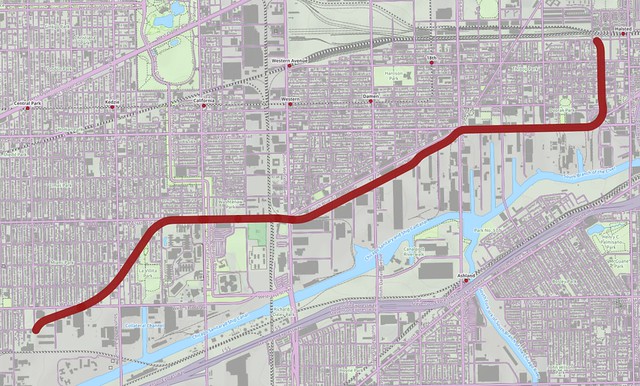[The Chicago Reader recently launched a new weekly transportation column written by Streetsblog Chicago editor John Greenfield. This partnership will allow Streetsblog to extend the reach of our livable streets advocacy. We’ll be syndicating a portion of the column on the day it comes out online; you can read the remainder on the Reader’s website or in print. The paper hits the streets on Thursdays.]
Last Wednesday, as I Divvied southwest along a disused Burlington Northern Santa Fe railroad corridor in Little Village, I caught the delicious aroma of fresh corn tortillas from the nearby El Milagro plant. I rolled past the razor wire-topped walls of the Cook County jail, then stopped to check out La Villita Park, a green space on a former brownfield site. The corridor continued southwest past the Semillas de Justicia (“Seeds of Justice”) Community Garden, various industrial businesses, and a few colorful murals, ending near the Paul Simon Job Corps Center.
This street-level right-of-way, a mix of asphalt, rutted gravel roads and weed-strewn lots, winds from 26th and Rockwell to 32nd and Central Park. Since early 2015, the city has been doing community outreach for its plan to turn the stretch of land into a paved 1.3-mile multi-use trail called the Little Village Paseo (“Promenade”), with attractive landscaping, gathering places, and public art.
On Sunday, Mayor Emanuel upped the ante with a surprise announcement that the plan has been expanded to include another 2.7 miles of largely abandoned BNSF right-of-way. The resulting four-mile trail, now simply called the Paseo, will go all the way northeast to 16th and Sangamon in Pilsen, and feature artwork that celebrates Latino culture.
The first trail section, along Sangamon between 21st and 16th, will start out as a simple paved path that will be built this summer [as part of a BNSF and U.S. Environmental Protection Agency lead abatement project]. There’s no timeframe or cost estimate yet for the rest of the trail.
While the 606—the 2.7-mile, $95 million trail that debuted on the northwest side last June—is an elevated, car-free greenway, the south-side facility will be a cheaper, simpler, at-grade trail with street crossings. But renderings suggest its aesthetics and amenities will be several notches above a garden-variety bike path.
Neighbors previously voiced apprehension that, like the 606, the Little Village Paseo would lead to higher property values, property taxes, and rents, eventually pricing out longtime locals. The mayor’s announcement that the trail will now reach Pilsen brings that concern to the forefront.
Unlike Little Village, Pilsen has seen rapid gentrification in recent years, including a wave of upscale retail and housing, so the Paseo’s potential to fuel displacement will be an especially pressing issue there. (The median home sale price in Pilsen is $241,000, according to Zillow. Little Village is cheap by comparison, with a median home sale price of just $129,000.)
I heard concerns over displacement last Wednesday, when the Chicago Department of Transportation unveiled the results of a feasibility study for the Little Village portion of the Paseo during a community meeting at Kanoon elementary.
Elva Rodriguez Ochoa, a local who works at the nonprofit Openlands, said she’s excited to have a place to run nearby instead of having to schlep to the lakefront. “But it’s important for our community to be proactive and work with the city to find ways to keep the areas near the trail affordable,” she said.
The Little Village Environmental Justice Organization has also been involved with discussions about the trail. They spearheaded successful campaigns to shut down the nearby Fisk and Crawford coal-fired power plants and transform a pair of brownfields into the park and community garden.
“Folks who fought for these things should be able to stay in the neighborhood and enjoy them,” said organizing and strategy director Kim Wasserman-Nieto, a lifelong Little Village resident. “[LVEJO has] made it clear to the city that, unless they do this project in a holistic manner, we may find ourselves on opposite sides of the issue.”





